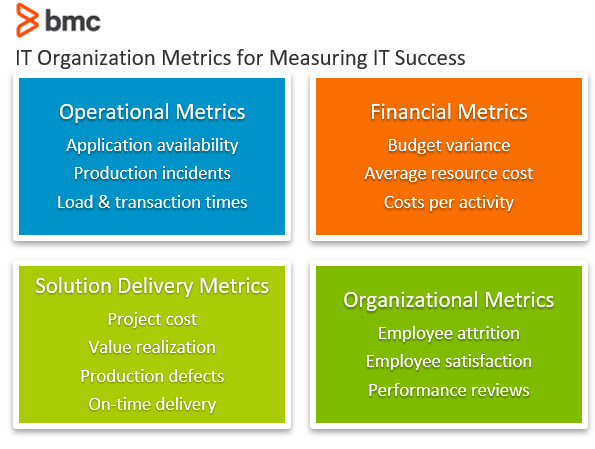IT benchmarking provides valuable input into how other businesses are tackling critical initiatives. Benchmarking can offer a high-level view and a helpful frame of reference for your work in order to inform your decisions and overall IT strategy.
By benchmarking your IT activities and investments against your peers, you can:
- See if you are over- or under-spending
- Get a sense for the market
- Make a case for or against a particular expenditure
These data points can be especially helpful when researching a new solution, building a business case, or justifying a project to your manager.
There are all kinds of benchmarking metrics in IT. In this article, we will:
- Define benchmarking in IT
- Look at 5 IT areas to benchmark
- Show where to find benchmarks
- Offer some advice on measuring too much
Let’s get started.
What is benchmarking?
Metrics can provide value only when measured in the right context. When first collecting a metric, how will you know if the result is “good” or “needs improvement”? Enter benchmarks.
Benchmarks are a standard against which to measure your own metrics.
Benchmarking is a general business practice that measures an organization’s quality and performance. Benchmarking is a formal way of comparing the practices, processes, and outcomes of your organization with others in your industry, and sometimes beyond it, to assess whether you’re performing above, on, or below average. It is primarily data-driven.
Benchmarking is not a one-time activity. Instead, it’s a way to continually understand industry averages to inform your strategy and expectations. Leaders use benchmarking to celebrate wins and to find process and performance gaps—after all, you can’t fix a problem you’re not aware of.
Some benefits of benchmarking include:
- Finding out where other businesses outperform yours
- Comparing the processes and strategies of your competitors
- Identifying areas to improve your services and general performance
- Understanding which activities contribute to efficiency and productivity—and which do not
- Determining whether and how quickly you’ve achieved ROI on investments
IT areas to benchmark
Several IT areas can benefit from benchmarking. However, it’s important first to analyze exactly what you want to accomplish with benchmarking. Identifying your overall objective will help you track what is right for your company. Some aspects to consider include:
- Your overall business goals
- Your decision-making process
- Your customers’ pain points and goals
- What is easy to measure and report
Once you have identified what is important to both your company and customers, you can start analyzing which areas you want to benchmark.
Let’s look common IT areas to consider benchmarking against the market.

IT operations efforts
IT operations require a number of activities vital to the health of your IT department. The effectiveness of your IT operations—and the ITOps team—touches every single department in your company. Consider all the areas ITOps supports:
- Maintaining infrastructures
- Onboarding and training new users
- Configuring new applications
- Maintaining security
- Ensuring service availability and reliability
- And much more!
The better your ITOps team can perform, the more advanced your business will be. Common areas to benchmark in IT operations include:
- Comparing your IT overhead costs to others in your industry can help save your company money and improve your bottom line.
- Looking at the number and types of service disruptions can also help you measure how well the services you provide stack up to the competition.
(Learn about tracking and measuring IT failures.)
Service management efforts
Your IT service management (ITSM) is critical your reputation as a business. If you develop great products or services, but deliver and manage them poorly, your customers will take notice and move on quickly.
With the right IT operations in place, service management is particularly driven by right processes and overall productivity, which all drive revenue.
Benchmarking is vital to finding areas of opportunity to improve and empower your IT department to have more effective processes and drive productivity. In terms of service management, you might start with the service desk and technical support. ITSM benchmarks can include:
- Improving call duration or the average time to answer a ticket can all have a powerful impact on every part of your business.
- Understanding the customer experience your service/help desk provides can also be a differentiator. After all, we know that customer experience is extremely important in fields that are crowded with competitive options.
Successful service desks have also defined which metrics they use to measure success. Regularly benchmark your performance on these metrics to others in your field, perhaps quarterly or semi-annually. Some common ITSM metrics include:
(Explore service desk benchmarks and overall service management metrics.)
Software development
Evaluating your software development can be a complicated process. You might have any number of separate software development projects or products to support, and each team might work the software development lifecycle (SDLC) differently. A benchmark that applies to one project might not apply to others.
Measuring success in this area will always depend on:
- The characteristics of the project
- Your overall goals
In a DevOps environment, you might look to measure (and therefore benchmark) areas such as:
- Time spent on innovation
- Number of defects avoided
- Agility
- Quality work or improvements released
As a software company, BMC has undergone its own DevOps transformation, and you can learn more about exactly how we benchmarked and measured success in this video:
Digital transformation efforts
Digital transformation is not merely a buzzword. Adopting new technology has become increasingly urgent, and it is obviously critical for businesses to remain competitive.
However, many IT departments struggle to execute a meaningful digital transformation for their companies—fewer than 30% of organizations actually succeed in their digital transformation pursuit. Even with the right technology, implementing the changes and getting your talent and culture on board with it will determine the success of any digital transformation. It requires:
- Setting the right goals
- Maximizing the assets that IT has
- Developing a practical roadmap to achieve success
To create a successful roadmap, you have to understand your current digital state. Competitive benchmarking may be helpful, but internal benchmarking can give you a better understanding of your current state.
A word of caution, though: Digital transformation benchmarks are tricky because each transformation it utterly unique. Your company’s transformation areas will vary from similar companies.
Instead of relying on traditional IT benchmarks, these measures provide deeper insight into your transformation:
- Scope of transformation
- Active usage of new technology
- User engagement
- Availability & reliability
- Risk factors
- Customer experience
- Innovation
IT organization benchmarks
Service management consultant Kirstie Magowan provides many metrics that help you assess the success of your overall IT organization, including all the previous areas. She suggests bucketing benchmarks into four keys areas, with metrics that support each one:
- Operational metrics
- Financial metrics
- Solution delivery metrics
- Organizational metrics

Where to find benchmarks
Once you figure out to benchmark, you have to collect data to start gaining insight. There are typically two types of benchmarking that IT departments use to get perspective:
- Internal
- Competitive
Internal benchmarking
Internal benchmarking is the practice of comparing your current efforts and output with previous efforts and output in your company.
For example, comparing year-over-year stats or checking in throughout a digital transformation can help your IT department stay on track.
Internal benchmarking requires that you have already established best practices for metrics. If you have not, you’ll have no uniform way to compare metrics over time.
Competitive/industry benchmarking
Competitive benchmarking is more common, and it’s particularly useful when you don’t have stable historic data on your own performance.
Competitive benchmarking helps you understand how your IT department compares to other similar companies. Companies can find industry benchmarks through:
- Reports from industry groups, like the Service Desk Institute
- Research analyst firms, like Gartner or Forrester
- Quarterly/annual statements from other companies
- Marketing representatives
- Anecdotes or casual discussions
A new benchmarking tool that helps companies measure their digital competitiveness is The ADE Index. It can highlight your current strengths and weaknesses, particularly around digital transformation. Knowing how your organization fares today helps you establish and plan for your short- and long-term goals more effectively.
Short for Autonomous Digital Enterprise, an ADE is a customer-centric, agile, and data-driven organization that minimizes manual effort to capitalize on human creativity, skills, and intellect. An ADE continuously examines its customer and partner relationships to create new value intelligently.
Caution on measuring
Knowing where you stack up and where you can improve is a key practice in any business. Still, companies can easily get too caught up in measuring, says Magowan. She explains how metrics should matter—to your customer. If you’re measuring something that ultimately has no impact on the customer, what’s the point?
Another take is Goodhart’s Law, a socioeconomic paradox that is summed up as:
“When a measure becomes a target, it ceases to be a good measure.”
Are you measuring to improve, or measuring to beat numbers?







